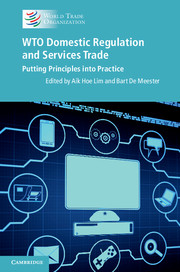Book contents
- Frontmatter
- Contents
- List of contributors
- Foreword
- Disclaimer
- Acknowledgements
- List of abbreviations
- 1 An introduction to domestic regulation and GATS
- Part I Impediments to services trade, regulatory theory and principles
- 2 Why regulate? An overview of the rationale and purpose behind regulation
- 3 Domestic regulation: what are the costs and benefits for international trade in services?
- Part II Legal perspectives on WTO principles and domestic regulations
- Part III Case studies
- Part IV Concluding remarks
- Index
- References
3 - Domestic regulation: what are the costs and benefits for international trade in services?
Published online by Cambridge University Press: 05 April 2014
- Frontmatter
- Contents
- List of contributors
- Foreword
- Disclaimer
- Acknowledgements
- List of abbreviations
- 1 An introduction to domestic regulation and GATS
- Part I Impediments to services trade, regulatory theory and principles
- 2 Why regulate? An overview of the rationale and purpose behind regulation
- 3 Domestic regulation: what are the costs and benefits for international trade in services?
- Part II Legal perspectives on WTO principles and domestic regulations
- Part III Case studies
- Part IV Concluding remarks
- Index
- References
Summary
Introduction
Services have been considered non-tradable and therefore outside the scope of trade policy-making until quite recently. A logical consequence is that explicit policy barriers to cross-border trade in services are rare. What segments markets for tradable services is therefore largely in the realm of domestic regulation. Both the General Agreement on Trade in Services (GATS) and a number of regional trade agreements (RTAs) aim at developing disciplines on domestic regulation. GATS Article VI states that disciplines on qualification requirements and procedures, technical standards and licensing requirements shall be established to ensure that regulation is not more burdensome than necessary to ensure the quality of the service. Such disciplines are, however, yet to be established, but a reference paper on pro-competitive domestic regulation in telecommunications has been included in a number of World Trade Organization (WTO) members’ GATS schedules of commitments, and some RTAs have quite detailed disciplines on domestic regulation in this sector.
The region where services market integration runs the deepest is the European Union. The Treaty of Rome of 1957 had already granted full market access for the signatories through cross-border trade as well as the movement of capital and labour, while the Internal Market Act aimed at removing barriers to the implementation of the letter as well as the intention of the Treaty of Rome. Nevertheless, domestic regulation turned out to be a formidable obstacle to the integration of services markets. In the words of the European Commission, ‘a decade after the envisaged completion of the internal market, there is still a huge gap between the vision of an integrated European Union economy and the reality as experienced by European citizens and providers’. Hence, a Services Directive aiming at lowering regulatory barriers to trade was introduced in 2006. Against this backdrop, this chapter will focus on empirical work on the European Union and the telecommunications sector.
- Type
- Chapter
- Information
- WTO Domestic Regulation and Services TradePutting Principles into Practice, pp. 47 - 62Publisher: Cambridge University PressPrint publication year: 2014



